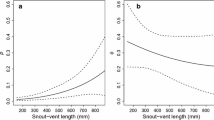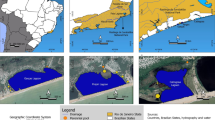Abstract
Climate change is predicted to alter the frequency and intensity of precipitation events, placing stress on freshwater aquatic ecosystems and their associated wildlife. Thus, understanding interspecific variation in drought sensitivity and the repeatability of those responses across heterogeneous landscapes is critical. Semi-aquatic snakes serve important roles within aquatic ecosystems and several species are threatened. Yet, little is known about the effects of drought on semi-aquatic snake populations or assemblages. We systematically trapped 20 isolated wetlands in South Carolina before (2006) and after (2013) a multi-year supra-seasonal drought to determine drought-induced shifts in occupancy and detection for five semi-aquatic snake species. Our results confirm that supra-seasonal drought differentially affects semi-aquatic snake species across landscape scales. Specifically, site occupancy decreased dramatically following drought for banded watersnakes (Nerodia fasciata) (0.95 to 0.69) and Florida green watersnakes (Nerodia floridana) (0.32 to 0.05), but was relatively unchanged for black swamp snakes (Seminatrix pygaea), mudsnakes (Farancia abacura) and glossy crayfish snakes (Regina rigida). Species lacking adaptations that make them resistant or resilient to drought may become locally extirpated if climate change projections are realized or landscapes are degraded or fragmented in ways that prevent drought recovery.



Similar content being viewed by others
References
Adams SB, Warren ML (2005) Recolonization by warmwater fishes and crayfishes after severe drought in upper coastal plain hill streams. Transaction of American Fish Society 134:1173–1192
Akaike H (1973) Information theory and an extension of the maximum likelihood principle. In: Petrov B, Csáki F (eds) second international symposium on information theory. Akademiai Kidao, Budapest, Tsahkadsor, Armenia, USSR, pp 267–281
Allen CD, Macalady AK, Chenchouni H, Bachelet D, McDowell N, Vennetier M, Kitzberger T, Rigling A, Breshears DD, Hogg ET (2010) A global overview of drought and heat-induced tree mortality reveals emerging climate change risks for forests. Forest Ecology Management 259:660–684
Amezaga J, Santamaría L, Green AJ (2002) Biotic wetland connectivity—supporting a new approach for wetland policy. Acta Oecologica 23:213–222
Arthington AH, Balcombe SR, Wilson GA, Thoms MC, Marshall J (2005) Spatial and temporal variation in fish-assemblage structure in isolated waterholes during the 2001 dry season of an arid-zone floodplain river, Cooper Creek, Australia. Marine and Freshwater Research 56:25–35
Bigler C, Kulakowski D, Veblen TT (2005) Multiple disturbance interactions and drought influence fire severity in Rocky Mountain subalpine forests. Ecology 86:3018–3029
Bond NR, Lake P, Arthington AH (2008) The impacts of drought on freshwater ecosystems: an Australian perspective. Hydrobiologia 600:3–16
Burnham KP, Anderson DR (2002) Model selection and multi-model inference: a practical information-theoretic approach. Springer, New York
Cahill AE, Aiello-Lammens ME, Fisher-Reid MC, Hua X, Karanewsky CJ, Ryu HY, Sbeglia GC, Spagnolo F, Waldron JB, Warsi O (2013) How does climate change cause extinction? Proceeding of the Royal Society Biological Science Series B 280:20121890
Canton SP, Cline LD, Short R, Ward JV (1984) The macroinvertebrates and fish of a Colorado stream during a period of fluctuating discharge. Freshwater Biology 14:311–316
Clarke KR, Gorley RN (2006) PRIMER v6. United Kingdom
Dai A (2011) Drought under global warming: a review. Wiley Interdisciplinary Reviews: Climate Change 2:45–65
Davis CE, Janecek LL (1997) DOE research set-aside areas of the Savannah River site. Savannah River Ecology Laboratory, Aiken, South Carolina
Dodd CK (1992) Biological diversity of a temporary pond herpetofauna in north Florida sandhills. Biodiversity and Conservation 1:125–142
Durso AM, Willson JD, Winne CT (2011) Needles in haystacks: estimating detection probability and occupancy of rare and cryptic snakes. Biological Conservation 144:1508–1515
Durso AM, Willson JD, Winne CT (2013) Habitat influences diet overlap in aquatic snake assemblages. Journal of Zoology (London) 291:185–193
ESRI (2011) ArcGIS desktop: release 10. Environmental Systems Research Institute, Redlands, California
Feng D, Beighley E, Hughes R, Kimbro D (2016) Spatial and temporal variations in eastern U.S. hydrology: responses to global climate variability. Journal of the American Water Resources Association 52:1089–1108
Ficklin DL, Maxwell JT, Letsinger SL, Gholizadeh H (2015) A climatic deconstruction of recent drought trends in the United States. Environmental Research Letters 10:044009
Gibbons JW, Dorcas ME (2004) North American Watersnakes: a natural history. University of Oklahoma, Norman, Oklahoma, USA
Harrell F (2001) Regression modeling strategies: with applications to linear models, logistic regression, and survival analysis. Springer, Cham, Switzerland
Harrison RD (2000) Repercussions of El Niño: drought causes extinction and the breakdown of mutualism in Borneo. Proceeding of the Royal Society Biological Science Series B 267:911–915
Hines JE (2006) PRESENCE - software to estimate patch occupancy and related parameters 2.4 edition. United States geological survey, Patuxent wildlife research center, Laurel, Maryland
Hynes H (1958) The effect of drought on the fauna of a small mountain stream in Wales. Verh Internat Verein. Theor Angew Limnol 8:826–833
Jury E (1964) Theory and application of the Z-transform method. John Wiley and Sons, Inc., New York
King RB, Queral-Regil A, Stanford KM (2006) Population size and recovery criteria of the threatened Lake Erie watersnake: integrating multiple methods of population estimation. Herpetological Monographs 20:83–104
Knight D (1987) Parasites, lightning, and the vegetation mosaic in wilderness landscapes. In: Turner M, Bogucki D, Bormann F, Box E, Bratton S, Dolan R, Dunn C, Forman R, Gruendling G, Guntenspergen G, Hayes T, Leitner L, Meentenmeyet V, Morrison D, Nassauer J, Odum W, Pace W III, Remillard M, Riskind D, Risser P, Sharpe D, Smith T III, Stearns F, Turner M, Westmacott R (eds) Landscape heterogeneity and disturbance. Springer, New York, pp 59–83
Kock R (2005) What is this infamous “wildlife/livestock disease interface?” a review of current knowledge for the African continent. In: Osofsky SA (ed) Conservation and development interventions at the wildlife/livestock Interface: implications for wildlife, livestock and human health. IUCN species survival commission, Margate, United Kingdom, pp 1–13
Lake P (2000) Disturbance, patchiness, and diversity in streams. Journal of North American Benthological Society 19:573–592
Lake P (2003) Ecological effects of perturbation by drought in flowing waters. Freshwater Biology 48:1161–1172
Larimore RW, Childers WF, Heckrotte C (1959) Destruction and re-establishment of stream fish and invertebrates affected by drought. Transactions of the American Fisheries Society 88:261–285
Lillywhite HB, Tu M-C (2011) Abundance of sea kraits correlates with precipitation. PLoS One 6:e28556
MacKenzie DI, Bailey LL (2004) Assessing the fit of site-occupancy models. Journal of Agricultural, Biological, and Environmental Statistics 9:300–318
MacKenzie DI, Nichols JD, Sutton N, Kawanishi K, Bailey LL (2005) Improving inferences in population studies of rare species that are detected imperfectly. Ecology 86:1101–1113
MacKenzie DI, Nichols JD, Royle JA, Pollock KH, Bailey LL, Hines JE (2006) Occupancy estimation and modeling: inferring patterns and dynamics of species occurrence. Academic Press, San Diego
Magoulick DD, Kobza RM (2003) The role of refugia for fishes during drought: a review and synthesis. Freshwater Biology 48:1186–1198
Martin CA (1998) An ecological profile of the western mud snake (Farancia abacura reinwardtii). MS thesis, Stephen F. Austin State University, Nacogdoches, Texas, USA
McVay JD, Carstens B (2013) Testing monophyly without well-supported gene trees: evidence from multi-locus nuclear data conflicts with existing taxonomy in the snake tribe Thamnophiini. Molecular Phylogenetics and Evolution 68:425–431
Pough FH (1980) The advantages of ectothermy for tetrapods. The American Naturalist 115:92–112
Pounds JA, Fogden MPL, Campbell JH (1999) Biological response to climate change on a tropical mountain. Nature 398:611–615
Rhind S, Bradley J (2002) The effect of drought on body size, growth and abundance of wild brush-tailed phascogales (Phascogale tapoatafa) in south-western Australia. Wildlife Research 29:235–245
Roe JH, Georges A (2007) Heterogeneous wetland complexes, buffer zones, and travel corridors: landscape management for freshwater reptiles. Biological Conservation 135:67–76
Roe JH, Kingsbury BA, Herbert NR (2004) Comparative water snake ecology: conservation of mobile animals that use temporally dynamic resources. Biological Conservation 118:79–89
Seigel RA, Gibbons JW, Lynch TK (1995) Temporal changes in reptile populations: effects of a severe drought on aquatic snakes. Herpetologica 51:424–434
Seneviratne SI, Nicholls N, Easterling D, Goodess CM, Kanae S, Kossin J, Luo Y, Marengo J, McInnes K, Rahimi M, Reichstein M, Sorteberg A, Vera C, Zhang X (2012) Changes in climate extremes and their impacts on the natural physical environment. In: Field CB, Barros V, Stocker TF, Qin D, Dokken DJ, Ebi KL, Mastrandrea MD, Mach KJ, Plattner G-K, Allen SK, Tignor M, Midgley PM (eds) Managing the risks of extreme events and disasters to advance climate change adaptation. A special report of working groups I and II of the Intergovernmental Panel on Climate Change (IPCC). Cambridge University Press, Cambridge, pp 109–230
Sperry JH, Weatherhead PJ (2008) Prey-mediated effects of drought on condition and survival of a terrestrial snake. Ecology 89:2770–2776
Steen DA, Stiles JA, Stiles SH, Guyer C, Pierce JB, Rudolph DC, Smith LL (2011) Regina rigida (glossy crayfish snake). Terrestrial Movements Herpetol Rev 42:102
Steen DA, Stevenson DJ, Beane JC, Willson JD, Aresco MJ, Godwin J, Graham SP, Smith L, Howze J, Rudolph DC, Pierce J, Lee J, Gregory B, Jensen J, Stiles S, Stiles J, Nazdrowicz N, Guyer C (2013) Terrestrial movements of the red-bellied Mudsnake (Farancia abacura) and rainbow snake (F. erytrogramma). Herpetological Review 44:208–213
Thomas CD, Cameron A, Green RE, Bakkenes M, Beaumont LJ, Collingham YC, Erasmus BF, De Siqueira MF, Grainger A, Hannah L (2004) Extinction risk from climate change. Nature 427:145–148
Thompson S, Seber G (1996) Adaptive sampling. John Wiley & Sons, New York
Trape S (2009) Impact of climate change on the relict tropical fish fauna of central Sahara: threat for the survival of Adrar mountains fishes, Mauritania. PLoS One 4:e4400
Walls SC, Barichivich WJ, Brown ME, Scott DE, Hossack BR (2013a) Influence of drought on salamander occupancy of isolated wetlands on the southeastern coastal plain of the United States. Wetlands 33:345–354
Walls SC, Barichivich WJ, Brown ME (2013b) Drought, deluge and declines: the impact of precipitation extremes on amphibians in a changing climate. Biology 2:399–418
Wikelski M, Trillmich F (1997) Body size and sexual size dimorphism in marine iguanas fluctuate as a result of opposing natural and sexual selection: an island comparison. Evolution 51:922–936
Willson JD, Winne CT, Dorcas ME, Gibbons JW (2006) Post-drought responses of semi-aquatic snakes inhabiting an isolated wetland: insights on different strategies for persistence in a dynamic habitat. Wetlands 26:1071–1078
Willson JD, Winne CT, Keck MB (2008) Empirical tests of biased body size distributions in aquatic snake captures. Copeia 2008:401–408
Winne CT (2008) Seminatrix pygaea, A model of ecological resilience in dynamic habitats. Ph. D. dissertation, University of Georgia, Athens, Georgia, USA
Winne CT, Ryan TJ, Leiden Y, Dorcas ME (2001) Evaporative water loss in two natricine snakes, Nerodia fasciata and Seminatrix pygaea. Journal of Herpetology 35:129–133
Winne CT, Willson JD, Gibbons JW (2006) Income breeding allows an aquatic snake Seminatrix pygaea to reproduce normally following prolonged drought-induced aestivation. The Journal of Animal Ecology 75:1352–1360
Winne CT, Willson JD, Gibbons JW (2010) Drought survival and reproduction impose contrasting selection pressures on maximum body size and sexual size dimorphism in a snake, Seminatrix pygaea. Oecologia 162:913–922
Acknowledgements
This work was supported by the Department of Energy Office of Environmental Management [Award Number DE-FCO9-07SR22506]. We thank the University of Arkansas for support and funding and the Savannah River Ecology Laboratory (SREL) for providing logistical support. We thank Tracey Tuberville for graciously hosting us at SREL and Whit Gibbons, Brett DeGregorio, and Stacey Lance for logistical support and encouragement. We also thank Mark Vukovich, Joy Vukovich, Caitlin Rumrill, Becca Phillips, Brian Metts, Sean Poppy, Melissa Pilgrim, Kimberly Andrews, Gregory Skupien, Clay Noss, Mike Epperly, Wes Flynn, Cara Love, Joseph Colbert, Andrew Cronin, Matt Atkinson, David Scott, and Angela Lindell for support, and field assistance. See also acknowledgments in Durso et al. (2011).
Author information
Authors and Affiliations
Corresponding author
Rights and permissions
About this article
Cite this article
Vogrinc, P.N., Durso, A.M., Winne, C.T. et al. Landscape-Scale Effects of Supra-Seasonal Drought on Semi-Aquatic Snake Assemblages. Wetlands 38, 667–676 (2018). https://doi.org/10.1007/s13157-018-1009-6
Received:
Accepted:
Published:
Issue Date:
DOI: https://doi.org/10.1007/s13157-018-1009-6




